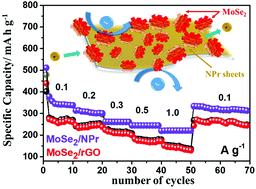当前位置:
X-MOL 学术
›
Inorg. Chem. Front.
›
论文详情
Our official English website, www.x-mol.net, welcomes your
feedback! (Note: you will need to create a separate account there.)
A high-performance sodium anode composed of few-layer MoSe2 and N, P doped reduced graphene oxide composites†
Inorganic Chemistry Frontiers ( IF 6.1 ) Pub Date : 2018-06-29 00:00:00 , DOI: 10.1039/c8qi00331a Amlan Roy 1, 2, 3, 4, 5 , Arnab Ghosh 1, 2, 3, 4, 5 , Ajit Kumar 1, 2, 3, 4, 5 , Sagar Mitra 1, 2, 3, 4, 5
Inorganic Chemistry Frontiers ( IF 6.1 ) Pub Date : 2018-06-29 00:00:00 , DOI: 10.1039/c8qi00331a Amlan Roy 1, 2, 3, 4, 5 , Arnab Ghosh 1, 2, 3, 4, 5 , Ajit Kumar 1, 2, 3, 4, 5 , Sagar Mitra 1, 2, 3, 4, 5
Affiliation

|
The renewable energy revolution and its practical applications demand the need for large solar storage options. Lithium-ion batteries may remain top in terms of their utilization and performance, however their cost-per-kWh impacts their usage, and researchers prefer to stick to sodium-ion chemistry as a large storage option. One of the main research topics for rechargeable sodium-ion batteries is in proposing new anodes, since the commercial graphite anode is incompatible for use in SIBs as its larger radius (0.98 Å vs. 0.69 Å of Li+) leads to sluggish Na-ion transport during the cycling process. Our team is continuously working on the development of chalcogenide-based anodes for use in sodium-ion batteries and their reaction mechanisms. In this work, we prepared MoSe2 and MoSe2-N, P-doped rGO composites (with the latter denoted as MoSe2/NPr) as active anodes for use in sodium-ion batteries. The morphology and electrochemical properties of MoSe2/NPr were characterised and compared with those of the bare MoSe2 electrode. The MoSe2/NPr composite delivers a capacity of 337 mA h g−1 at 0.1 A g−1 after 100 cycles and 244.4 mA h g−1 at 1 A g−1; these values are higher than those of MoSe2/rGO (225.6 mA h g−1 at 0.1 A g−1) and MoSe2 electrodes (206 mA h g−1 at 0.1 A g−1). The excellent performance of MoSe2/NPr is attributed to the interconnected doped rGO sheets that provide sufficient active sites for MoSe2 with improved conductivity and reduced volume expansion during the cycling process. In addition, the sodium storage mechanism is investigated by several ex situ physical and microscopic studies.
中文翻译:

由少量MoSe 2和N,P掺杂的还原氧化石墨烯复合材料组成的高性能钠阳极†
可再生能源革命及其实际应用需要大量的太阳能存储选项。锂离子电池的利用率和性能可能仍居首位,但是每千瓦时的成本会影响其使用率,因此研究人员倾向于坚持使用钠离子化学作为大型存储选择。其中一个主要的研究课题可充电的钠离子电池是在提出新的阳极,因为商业石墨阳极是不相容用于SIB的为较大的半径(0.98与0.69李+)导致低迷的钠离子骑车过程中的运输。我们的团队一直在致力于开发用于钠离子电池的硫族化物基负极及其反应机理。在这项工作中,我们准备了MoSe 2以及用作钠离子电池的活性阳极的MoSe 2 -N,P掺杂的rGO复合材料(后者表示为MoSe 2 / NPr)。对MoSe 2 / NPr的形貌和电化学性能进行了表征,并与裸MoSe 2电极进行了比较。在摩西2 / NPR复合递送容量337毫安汞柱-1在0.1 A克-1后100次循环和244.4毫安汞柱-1 1 A G -1 ; 这些值比MOSE的较高2(225.6毫安HG / RGO -1 0.1 A G -1)和摩西2个电极(206毫安汞柱-1在0.1A g -1)。MoSe 2 / NPr的优异性能归因于相互连接的掺杂rGO薄板,该薄板在循环过程中为MoSe 2提供了足够的活性位点,具有改善的导电性和减小的体积膨胀。此外,钠盐的贮藏机制通过一些非原位的物理和显微镜研究进行了研究。
更新日期:2018-06-29
中文翻译:

由少量MoSe 2和N,P掺杂的还原氧化石墨烯复合材料组成的高性能钠阳极†
可再生能源革命及其实际应用需要大量的太阳能存储选项。锂离子电池的利用率和性能可能仍居首位,但是每千瓦时的成本会影响其使用率,因此研究人员倾向于坚持使用钠离子化学作为大型存储选择。其中一个主要的研究课题可充电的钠离子电池是在提出新的阳极,因为商业石墨阳极是不相容用于SIB的为较大的半径(0.98与0.69李+)导致低迷的钠离子骑车过程中的运输。我们的团队一直在致力于开发用于钠离子电池的硫族化物基负极及其反应机理。在这项工作中,我们准备了MoSe 2以及用作钠离子电池的活性阳极的MoSe 2 -N,P掺杂的rGO复合材料(后者表示为MoSe 2 / NPr)。对MoSe 2 / NPr的形貌和电化学性能进行了表征,并与裸MoSe 2电极进行了比较。在摩西2 / NPR复合递送容量337毫安汞柱-1在0.1 A克-1后100次循环和244.4毫安汞柱-1 1 A G -1 ; 这些值比MOSE的较高2(225.6毫安HG / RGO -1 0.1 A G -1)和摩西2个电极(206毫安汞柱-1在0.1A g -1)。MoSe 2 / NPr的优异性能归因于相互连接的掺杂rGO薄板,该薄板在循环过程中为MoSe 2提供了足够的活性位点,具有改善的导电性和减小的体积膨胀。此外,钠盐的贮藏机制通过一些非原位的物理和显微镜研究进行了研究。











































 京公网安备 11010802027423号
京公网安备 11010802027423号